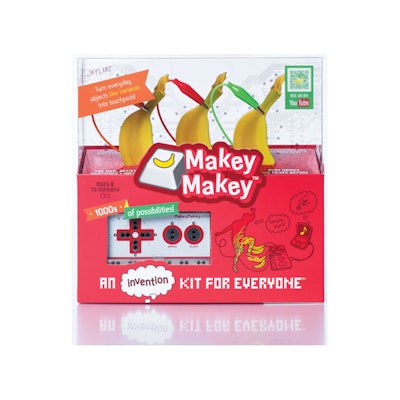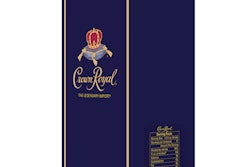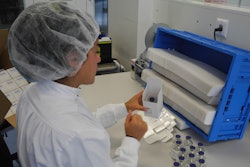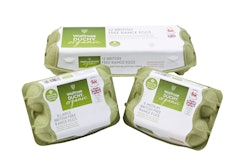It’s well documented that a consumer will spend just seconds scanning retail shelves before either picking up a product or moving on. The role of package design is to grab that consumer’s attention instantly, drawing them to the product and clearly communicating to them its uses and benefits. But what if that product is an abstract invention that’s never before been seen on store shelves? That’s the challenge MERGE Design + Interactive faced when it began working with JoyLabz to redesign the packaging for its Makey Makey product for a retail debut.
Described as “an invention kit for the 21st century,” Makey Makey is an interactive product that lets consumers connect everyday objects to a computer and turn those objects into Internet touchpads. For example, bananas can be used to play the piano online, and bits of Play Doh can be used as control buttons for Super Mario Brothers—the applications are endless.
Makey Makey was originally funded through a Kickstarter campaign that raised more than $500,000. After introducing the product in 2012, JoyLabz had great success selling the product online to those in the “maker” culture—a technology-based extension of the DIY culture. In spring 2014, JoyLabz sought to bring its product to retail. What it found though was that its product packaging required more kick than its current carton provided.
“At that time, the original packaging, which had been designed by a friend of the company, was doing its job,” explains Robert Ator, Associate Creative Director for MERGE. Small and simple, the box easily contained the product’s components: one Makey Makey circuit board, seven alligator clips, 1 USB cord, 6 connector wires, instructions, and some quirky stickers.
“But when the team at JoyLabz was ready to take the product to the mass market, it had difficulty selling Makey Makey into big box or specialty stores,” Ator adds. “Buyers were confused by what the product was and what it did. And with a $50 to $60 price point, buyers and consumers alike had a hard time justifying the purchase. Makey Makey needed a complete branding and packaging overhaul to have a chance at retailer planograms. That’s where the relationship between JoyLabz and MERGE began.”
Package as interactive experience
As Ator explains, MERGE’s strategy for the new Makey Makey package design was to create an engaging and visual interactive experience for consumers. In contrast to the small, simple box used for online sales, Ator says the new retail package needed “a ‘bells and whistles’ design to signal the tech toy’s unique and quirky proposition.
“After speaking with the client and becoming more familiar with the product itself, we realized that the [online] package was missing one of the biggest aspects of all (though not tangible)—the excitement and hilarity the product brought to the people who used it. It was pretty clear right away that we had to create something just as outrageous as the product itself.”
During the discovery process, MERGE visited several retailers to find inspiration, primarily focusing on product packaging for kids’ toys and electronics at stores like Best Buy and Target. Catching their eye was a pair of high-end headphones that used clear PET packaging to reveal part of the product. “We really thought the shelf presence was striking,” says Ator. “We took that execution, and instead of using it to highlight the Makey Makey itself, we used it to highlight the exciting things you can do with it.”
The resulting secondary package comprises a two-piece carton, with the lower half constructed of paperboard, and the upper half of clear plastic PET that showcases a “banana piano diorama” inside. In the diorama, three cutout bananas stand upright from the top of the lid of the lower carton. Attached to each is a colorful alligator clip. An orange banner graphic printed on the PET window reads: “Turn everyday objects like bananas into touchpads.”
Explains Ator, “After much brainstorming and watching hours of Makey Makey inventions on YouTube, we thought the banana piano was the most ownable invention in the market. This is why we ultimately produced the banana piano diorama. It’s the invention most consumers think of and can easily create at the onset of use.”
In the lower carton rests a 51⁄2 x 23⁄4 x 2-in. tin collector’s case that holds the Makey Makey components. The case not only protects the consumer’s investment by keeping the circuit board safe while it’s being carried from place to place, but it also keeps the brand in front of the consumer. The top of the tin is decorated with artwork commissioned by JoyLabz co-founder Jay Silver. Titled “World as Construction Kit,” by artist Sophie Diehl, the art, Ator explains, is Silver’s way of showing people that their world is as interesting as they allow it to be.
Vintage touches, vibrant colors
As for the package graphics, bright colors, a refreshed product illustration, custom fonts, and other art elements convey the energy and inventiveness of the brand—while still communicating the home-made, scrappy, and unpretentious feel of the original packaging.
“Jay Silver and the rest of his team at JoyLabz loved the not-so-polished aesthetic of the original logo and packaging. The loose design style of the brand mirrored the inventions it allowed people to build,” says Ator. “It was important that the logo refresh and new packaging took on some of this aura; the client didn’t want Makey Makey looking like it had gone completely ‘mainstream’ and away from its origins or initial consumer target.”
Color plays a big role in the new branding, with the paperboard carton printed in a bright red (Pantone 185C) that stands out on the retail shelf against the sea of black found with similarly priced electronic products. Inside, the alligator clips are colored to coordinate with the new brand colors—red, yellow, orange, and green.
Other branding elements—such as some fonts and illustrations—were inspired by old-school videogame controllers. Copy on the front panel reading, “An invention kit for everyone” and “Ages 8 to infinity,” is presented in a pixel font. Artwork includes a pixel alien, a camera burst, and up/down arrows printed on the back of the carton. MERGE also refreshed the product concept illustration on the front of the package to depict a hand-drawn figure in motion playing the banana piano.
Ator says the vibrant colors of the package were achieved via CMYK printing, with some of the details and the logo highlighted with a spot UV coating. Printed faintly on the back of the clear PET box is a circuit board pattern that lends detail, while maintaining the diorama look. The clear window also provides an additional print area for some of Silver’s philosophical sayings.
JoyLabz sees strong sales
The new Makey Makey Collector’s Edition packaging was introduced at retail in November 2014, and since then has been an enormous success for JoyLabz. Says MERGE’s Merchandising Director, Genji Leclair, “JoyLabz co-founder Scott Brown has constant re-orders as the product continues to sell week in and week out.”
Makey Makey in the new retail packaging is available in all Marbles: The Brain Store locations, in Michaels, and in Toys “R” Us as well as online through Amazon.com and MakeyMakey.com.
VIDEO: See how Makey Makey works at: pwgo.to/1845


























